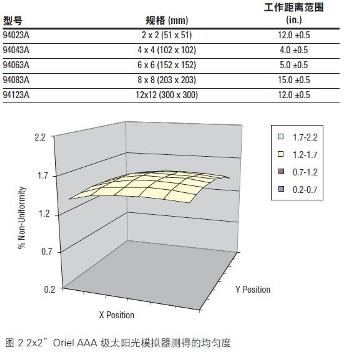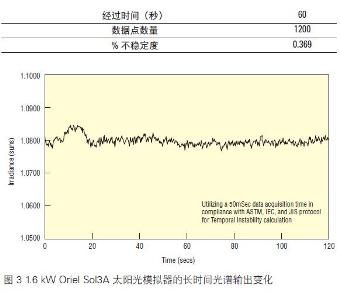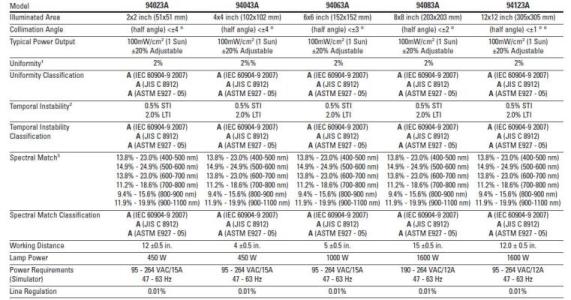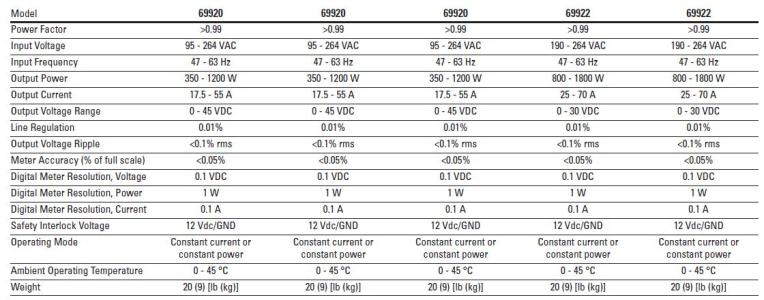Feature:
• Output beam sizes 2 x 2", 4 x 4", 6 x 6", 8 x 8", and 12 x 12"
• Factory certified Class AAA CW systems
• Calibration certificate validating Class AAA performance for all 3 standards: IEC, ASTM and JIS
• Long-lived, highly reliable instruments designed specifically for 24/7 production environments
• Non-reflective black finish reduces stray light
• Temperature sensors and interlocks ensure operator safety
• CE certified
Leveraging over 40 years of experience in light source and power supply design, Newport's Oriel® brand is proud to introduce the latest innovation in solar simulators – the Oriel Sol3A™ Class AAA Solar Simulator family.
All Oriel Sol3A simulators are certified to IEC 60904-9 Edition 2 (2007), JIS C 8912, and ASTM E 927-05 standards for Spectral Match, Non-Uniformity of Irradiance, and Temporal Instability of Irradiance. By convention, Class AAA is reported with the first letter representing Spectral performance, the second letter Uniformity of Irradiance, and the third letter Temporal Stability. The Oriel Sol3A simulators all use a single lamp design to meet not one or two, but all three performance criteria without compromising the 1 Sun output power, providing true Class AAA performance. The Oriel Sol3A uses a black non-reflective finish to minimize stray light and incorporates captive screws for all panels requiring user access to facilitate lamp replacement, alignment, and filter changes. Safety interlocks prevent inadvertent exposure to UV light. The Oriel Sol3A rugged design is backed by the Newport Corporation's world wide organization.
Why Class AAA?
Photovoltaic (PV) cell research and manufacturing are evolving at an amazing rate, with new technologies like thin film processes,tandem junction and multi-junction cells, organic thin films and dye sensitized cells all requiring careful evaluation of their performance. The old designation of "Class A" solar simulators had become standard in most test laboratories and manufacturing environments, but the definition of Class A has degraded to mean a system that is capable of meeting any one (typically spectral match) of the three performance parameters called out in the test methods. In October 2007 the IEC revised the method used to evaluate the performance of a solar simulator. The new standard calls for quantifying and reporting the performance of each of three performance criteria separately. A solar simulator is now measured as class A, B, or C for Spectral Match, Non-Uniformity of Irradiance, and Temporal Instability of Irradiance. The new Sol3A solar simulators have been designed to meet Class A performance for all 3 of the test
requirements, Spectral Match, Non-Uniformity of Irradiance, and Temporal Instability of Irradiance as called out by IEC 60904-9 Edition 2 (2007) edition, JIS C 8912, and ASTM E 927-05.
By ensuring measurement uniformity that allows results comparability and traceability, Class AAA systems reduce binning variability of photovoltaic cell testing as compared to so called Class A, Class B or non-classified sources. This performance consistency allows for precise comparison of performance data for researchers engaged in developing novel solar materials.
Newport Corporation puts each Oriel Sol3A™ through rigorous testing for all 3 standards (IEC, STM, and JIS) to insure compliance and supplies a certificate of calibration for all three standards.
Defining Class AAA Performance Standards
Photovoltaic standards mandate that Class AAA solar simulators meet demanding requirements in three key performance areas: spectral match to the solar spectrum, spatial non-uniformity of irradiance, and temporal instability of irradiance. There are three standards that define solar simulator performance.
• IEC 60904-9 Edition 2 (2007) Photovoltaic Devices – Part 9:Solar Simulator Performance Requirements
• JIS C 8912-1998, Solar Simulators for Crystalline Solar Cells and Modules
• ASTM E 927-05 (2005) Specification for Solar Simulation for Terrestrial PV Testing
Table 1 Class AAA Standards and Specifications

Spectral Match
The standards define the spectral match of a solar simulator as a percentage of the integrated intensity in 6 spectral ranges (listed in Table 2). Any deviation from the specified percentages must then lie within a range that determines the class of the simulator. For Class AAA, this range is 0.75 to 1.25 times the ideal percentage. International Standards for Solar Simulation
Spectral Distribution
The reference spectral distribution of sunlight at global Air Mass 1.5 is defined in ASTM G173-03 and IEC 60904-3. Although these tables include the spectrum from 280 nm to 4000 nm, for classification of solar simulation systems, this is restricted to the wavelengths from 400 nm to 1,100 nm. This spectral bandwidth is defined in reference IEC 60904-9 and ASTM E927-05. The spectral match of the Sol3A is classified for the range of 400-1100 nm.
To ensure that the Oriel Sol3A™ Solar Simulator falls reliably within this range, Newport uses a proprietary, highly stable spectral correction filter. This proprietary filter can withstand the very high intensity from the lamp without changing spectral properties. The result is the spectral output shown in Figure 1.
Spectral Match
Table 2 Ideal Spectral Match Defined by
IEC Standards

Spatial Uniformity of Irradiance
The irradiance uniformity over the work area is the most difficult Class AAA requirement to achieve and maintain. Hot spots can lead to significant errors in measured cell efficiency and can cause inaccurate binning of cells. The Class AAA spatial nonuniformity performance standard is designed to minimize the impact of hot spots and has a very stringent requirement of ≤2%. The plot below shows the uniformity of the irradiance across a typical simulator working area. Each unit will come with a plot of irradiance non-uniformity. The working distance ranges for each simulator are listed in Table 3.
Sol3A Working Distances
Table 3 Working Distances

Temporal Instability
Temporal Instability is the third performance parameter of Class AAA standards. It requires that the output light be stable over time in order to ensure that the lamp fluctuations do not distort the measurement of solar cell efficiency. Oriel's Sol3A easily meets the requirements for temporal instability as defined by the IEC, ASTM, and JIS standards. The IEC 60904-9 (2007) has the most stringent requirements for short term instability with a maximum allowable level of 0.5%. Figure 4 shows a typical instability response for an Oriel Sol3A utilizing a 50 millisecond data acquisition time.

Oriel Class AAA Solar Simulator Key Components
Illuminator Housing
The illuminator housing provides a safe enclosure for the lamp. Its powder coated flat black finish provides a durable surface that also minimizes stray light. It is equipped with safety interlock systems to ensure operator and system safety. Panels containing user serviceable components use captive screws that require no tools for ease of removal and replacement. Integral fan(s) provide forced air-cooling to maintain optimal lamp, optics and housing temperature. The Sol3A housing utilizes a design which allows the head orientation to produce a downward, sideways or upwards facing beam on the 2 x 2 or 4 x 4 models. Contact your Sales Engineer for details.
Integrated Shutter
The Oriel Sol3A Solar Simulator includes an upgraded shutter for production-environment operation. The newly designed shutter for the Class AAA systems is a rugged, single-blade shutter designed for >1 million cycles. Historically, our real-world performance has exceeded 10 million cycles on units in the field for many years.
The shutter has a minimum exposure time of 200 ms and can be controlled via a contact closure or logic level input, or a convenient push-button switch on the illuminator housing.
Xenon Arc Lamp
The Oriel Sol3A Solar Simulator source is a CW system. This enables testing of all cell materials unlike flash-lamp based systems that are limited by the response time of the material allowing the cell to be soaked at a constant light level prior to testing. The lamp is an ozone-free xenon short arc lamp. We certify each source with the supplied lamp. For continuous production environments, we suggest purchasing replacement lamps and an alignment palette to ensure Class AAA compliance as lamps are replaced.
Air Mass 1.5G Filter
The combination of lamp and air mass filter produces the characteristic Class AAA spectra. Our Air Mass 1.5G Filter retains its optical properties under the conditions encountered without degradation of the filter.
Power Supply
The Oriel regulated power supply incorporates over 40 years of experience in high voltage power supply design to provide constant electrical power to the xenon lamp. The power supply is CE compliant and features universal AC mains operation for use anywhere in the world. Lamp usage can be monitored in accumulated hours from the power supply, because it is important to replace the lamp at the end of its rated life to maintain the minimum 1 sun output and spectral characteristics. The lamp's output will significantly decrease and change spectrally with continued use beyond its rated life.
Maintaining the Oriel Sol3A Solar Simulator
Oriel Sol3A Solar Simulators maintain Class AAA compliance during the rated "performance lifetime" of the lamp. When the lamp is replaced, the instrument should be realigned to maintain Class AAA compliance. Irradiance uniformity is the most difficult Class AAA requirement to meet and maintain. In order to facilitate the measurements and adjustments necessary to maintain Class A uniformity, the Newport uniformity measurement tool (SOL-UMT) can be used to perform an automated test after lamp alignment following installation or replacement. The use of this tool can significantly reduce the time and effort required to maintain the Sol3A Solar Simulator within Class AAA specifications. *Please contact a Sales Engineer for details.
*Note: the use of these tools does not constitute re-certification of the system to Class A standards. For re-certification the entire Sol3A solar simulator must be returned to the factory. We recommend purchasing replacement lamps and certification at the time of purchase of the source. Contact a Sales Engineer for details.
Specifications
Class AAA Solar Simulator Specifications

Power Supply Specifications

1. Uniformity is defined as:
Uniformity (%) = (Max irradiance – Min irradiance)/ (Max irradiance + Min irradiance) x 100%
Uniformity is measured using following Methods:
• Compliant to IEC 60904-9 2007 edition - section 5.3, 64 points in an 8x8 grid with detector size no bigger than each grid size.
• Compliant to JIS C 8912 - section 4.2, 17 points in a pre-defined pattern with detector size no bigger than 2 x 2 cm square.
• Compliant to ASTM E 927-05 section 8.3, 64 points in an 8x8 grid with detector size no bigger than each grid size.
2. Temporal Instability is defined as:
Temporal Instability (%) = (Max irradiance – Min irradiance)/ (Max irradiance + Min irradiance) x 100%
Temporal instability is measured by taking 20 samples per second for 60 seconds.
3. Spectral match is measured by using a calibrated spectroradiometer with a grating monochromator and a discrete detector. Measurement resolution is set at 2 nm.
Ordering Information
Sol3A Ordering Information

Replacement Parts Lamps and Filters

Contact a Sales Engineer for pricing of optional accessories.